Discover 35 hidden attractions, cool sights, and unusual things to do in Winnipeg (Canada). Don't miss out on these must-see attractions: Manitoba Children's Museum, Manitoba Legislative Building, and Canada Life Centre. Also, be sure to include Rainbow Stage in your itinerary.
Below, you can find the list of the most amazing places you should visit in Winnipeg (Manitoba).
Table of Contents
Manitoba Children's Museum

Museum in Winnipeg, Manitoba. The Manitoba Children's Museum is a non-profit, charitable children's museum located at The Forks in Winnipeg, Manitoba, Canada.[1]
Address: 45 Forks Market Rd, R3C 4T6 Winnipeg (Central Winnipeg)
Manitoba Legislative Building
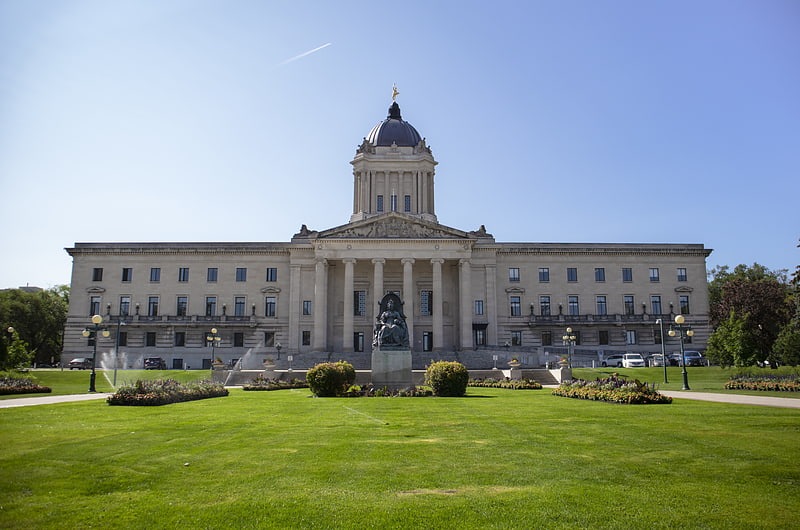
Building in Winnipeg, Manitoba. The Manitoba Legislative Building, originally named the Manitoba Parliament Building, is the meeting place of the Legislative Assembly of Manitoba, located in central Winnipeg, as well as being the twelfth provincial heritage site of Manitoba. Along with the Legislative Assembly, the building also accommodates the offices for Manitoba's Premier, the Lieutenant Governor, and the ministers and deputy ministers of provincial government departments.
The neoclassical, Beaux-Arts-style building was completed in 1920 along with its famed Golden Boy, a gold covered bronze statue based on the style of the Roman god Mercury (Greek: Hermes) that sits at the top of the building's cupola. Standing at 77 metres (253 ft) tall, it was designed and built by Frank Worthington Simon (1862–1933) and Henry Boddington III, along with other masons and many skilled craftsmen. With the abolition of the Legislative Council in 1876, the third building has a single chamber.[2]
Address: 450 Broadway, R3C 0V8 Winnipeg (Central Winnipeg)
Canada Life Centre

Arena in Winnipeg, Manitoba. Canada Life Centre is an indoor arena in downtown Winnipeg, Manitoba. The arena is the home of the National Hockey League's Winnipeg Jets and their American Hockey League affiliate, the Manitoba Moose.
The arena stands on the former Eaton's site and is owned and operated by True North Sports & Entertainment. The 440,000 square feet (41,000 m2) building was constructed at a cost of $133.5 million CAD. It opened on November 16, 2004, replacing the since-demolished Winnipeg Arena. It has a capacity of 15,321 for hockey and 16,345 for concerts.[3]
Address: Winnipeg, 300 Portage Avenue
Rainbow Stage
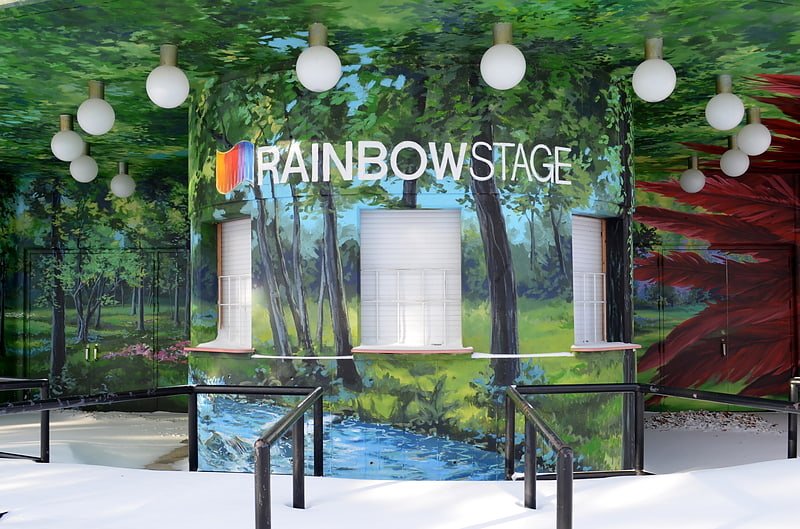
Theatre in Winnipeg, Manitoba. Rainbow Stage is the leading not-for-profit musical theatre company in Canada, as well as the country's largest and longest-running outdoor theatre, located in Kildonan Park in north Winnipeg, Manitoba. The covered amphitheatre seats up to 2,600 people and operates from May to September.[4]
Address: Kildonan Park, R2V 2B9 Winnipeg (Seven Oaks)
Air Force Heritage Museum and Air Park

Museum in Winnipeg, Manitoba. The Air Force Heritage Museum and Air Park, in Winnipeg, Manitoba displays aircraft and artifacts pertaining to the history of the Canadian Air Force. The park contains memorials to Canadian air search and rescue, and to the people who trained under the British Commonwealth Air Training Plan. The museum was established in 1975. Memorials in the park were dedicated in 1999.
The air park has the largest permanent display of Canadian military aircraft in Canada. The attached museum has artifacts such as aviation art, Victoria Crosses (including the posthumous award to Andrew Mynarski), and one of the remaining Battle of Britain lace tapestries.
Aircraft on static display include:
- CF 116 Freedom Fighter fighter
- CT 134 A Musketeer trainer
- CX 144 Challenger prototype air transport
- CH 136 Kiowa Helicopter
- CP-121 Tracker anti submarine warfare
- CF-104 Starfighter interceptor/fighter
- CF-101 Voodoo interceptor
- Harvard Mk. 4 Trainer
- CF 100 Canuck
- F86 Sabre Mk. VI
- CT-133 Silver Star
The park also displays the antenna from an AN/FPS 508 search radar from the Pinetree Line.[5]
Investors Group Field
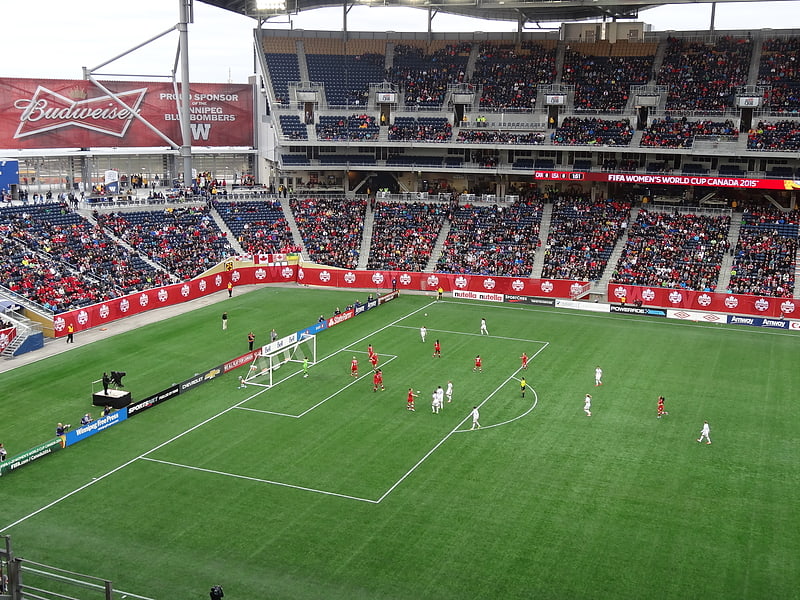
Stadium in Winnipeg, Manitoba. IG Field is a football stadium in Winnipeg, Manitoba, Canada. The stadium, which opened in 2013, is located on the University of Manitoba campus next to University Stadium. Owned by Triple B Stadium Inc. a consortium of the City of Winnipeg, the Province of Manitoba, the Winnipeg Football Club and the University of Manitoba, the stadium is home to the Winnipeg Blue Bombers of the Canadian Football League, Valour FC of the Canadian Premier League, the University of Manitoba Bisons football team, and the Winnipeg Rifles.
The stadium has a capacity of 33,134 and is partially covered. The stadium contains a corrugated metal roof, restaurant, 52 suites, walk of fame and other amenities.[6]
Address: 315 Chancellor Matheson Rd, R3T 1Z2 Winnipeg (Fort Garry)
Royal Aviation Museum of Western Canada
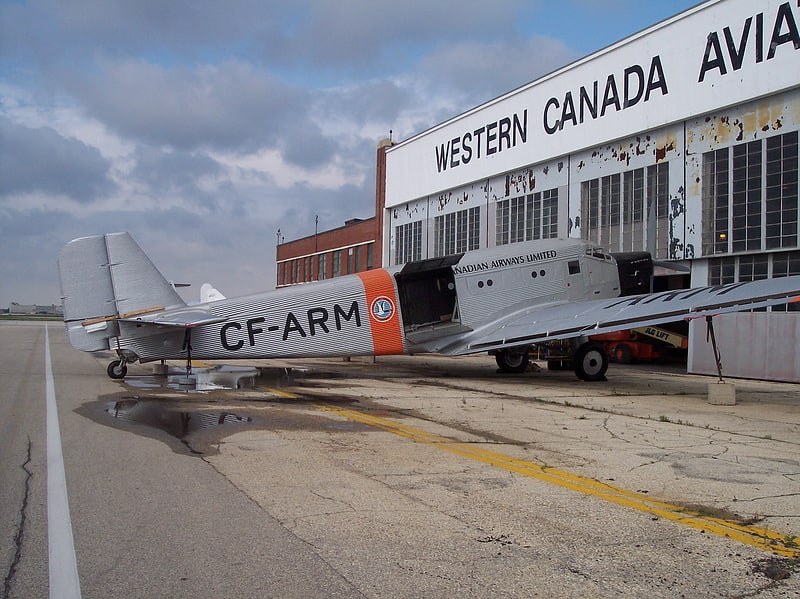
Museum in Winnipeg, Manitoba. The Royal Aviation Museum of Western Canada is a museum in Winnipeg, Manitoba, Canada. The museum is temporarily closed for relocation, and is scheduled to reopen in May 2022.[7]
Address: 958 Ferry Rd, R3H 0Y8 Winnipeg (Saint James-Assiniboia)
Canadian Museum for Human Rights
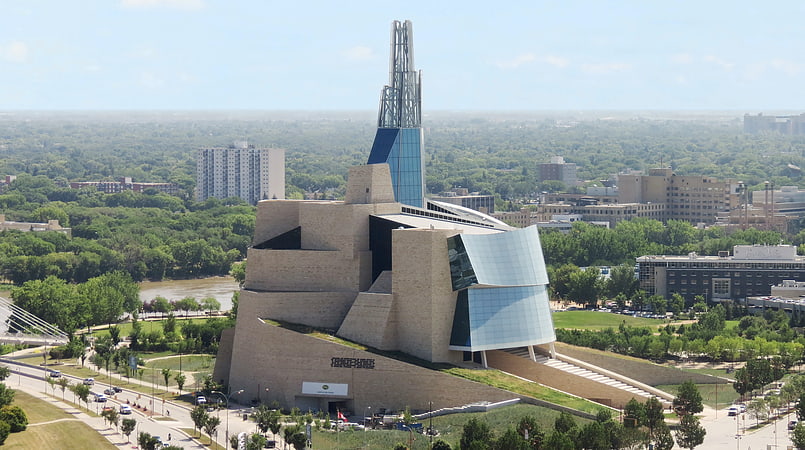
Modern museum with a global scope. The Canadian Museum for Human Rights is a Canadian Crown corporation and national museum located in Winnipeg, Manitoba, adjacent to The Forks. The purpose of the museum is to "explore the subject of human rights with a special but not exclusive reference to Canada, to enhance the public's understanding of human rights, to promote respect for others and to encourage reflection and dialogue."
Established in 2008 through the enactment of Bill C-42, an amendment of The Museums Act of Canada, the CMHR is the first new national museum created in Canada since 1967, and it is Canada's first national museum ever to be located outside the National Capital Region. The Museum held its opening ceremonies on 19 September 2014.
The Friends of the Canadian Museum for Human Rights is the charitable organization responsible for attracting and maintaining all forms of philanthropic contributions to the Museum.[8]
Address: 85 Israel Asper Way, R3C 0L5 Winnipeg (Central Winnipeg)
Kildonan Place
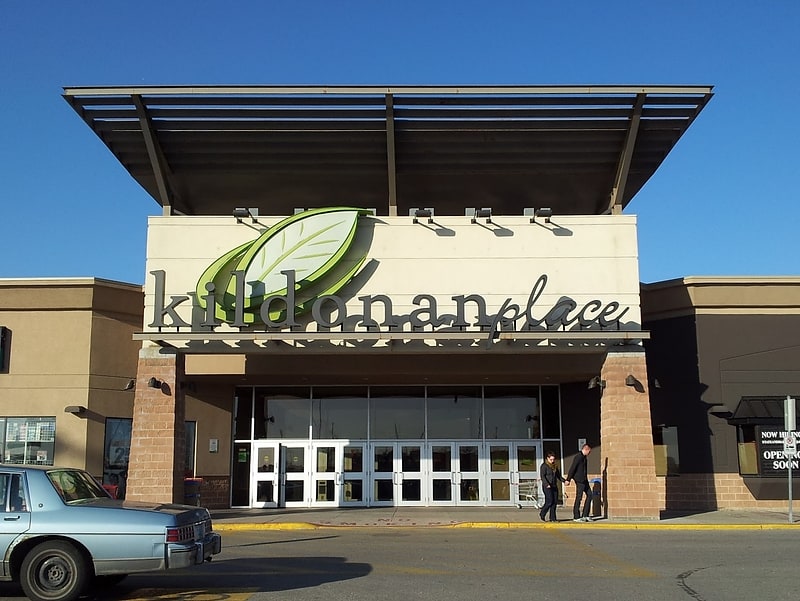
Shopping centre in Winnipeg, Manitoba. Kildonan Place is a shopping centre in Winnipeg, Manitoba, Canada, located in the neighbourhood of Transcona at 1555 Regent Avenue West.
The mall has 119 stores and services, a 6-screen theatre, and food court. It has 460,498 square feet (42,781.7 m2) of gross leaseable area.[9]
Address: Winnipeg, 1555 Regent Avenue West
Winnipeg Railway Museum
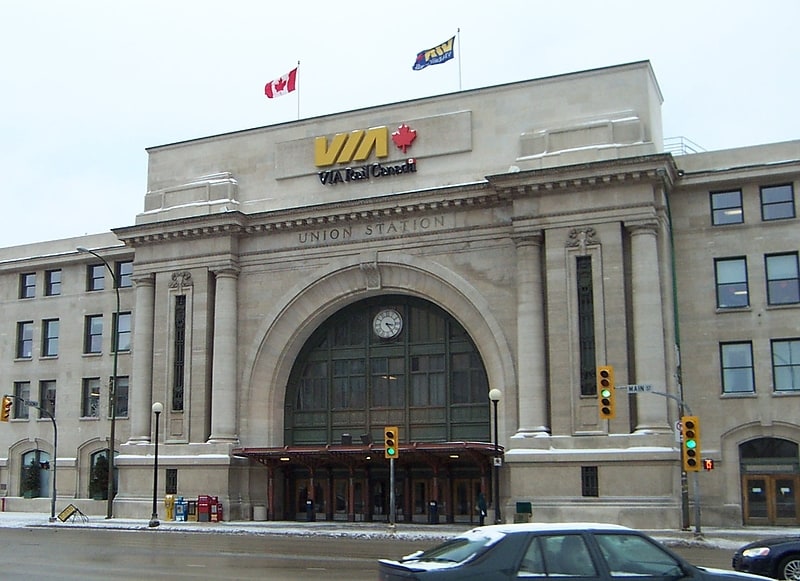
Museum in Winnipeg, Manitoba. The Winnipeg Railway Museum is a railway museum located on tracks 1 and 2 within the Via Rail-operated Union Station in Winnipeg, Manitoba, Canada. The museum is operated by volunteers from the Midwestern Rail Association Inc. a non-profit organization founded in 1975.
The Museum is affiliated with CMA, CHIN, Virtual Museum of Canada, and the Association of Manitoba Museums.[10]
Address: 123 Main St., R3C 1A3 Winnipeg (Central Winnipeg)
Saint Boniface Cathedral
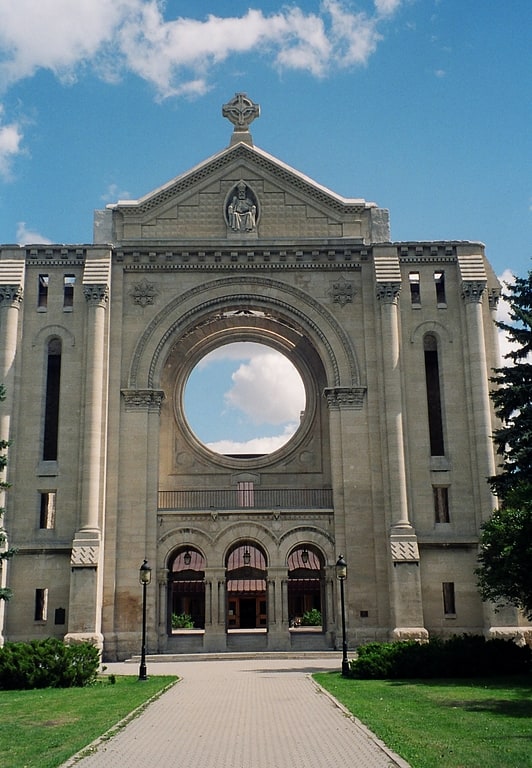
Catholic basilica with a 1906 facade. Saint Boniface Cathedral is a Roman Catholic cathedral of Saint Boniface, Winnipeg, Manitoba, Canada. It is an important building in Winnipeg, and is the principal church in the Roman Catholic Archdiocese of Saint Boniface, serving the eastern part of Manitoba province as well as the local Franco-Manitoban community. The church sits in the centre of the city at 190 avenue de la Cathédrale, Saint Boniface. Before the fire on July 22, 1968 which destroyed the previous building on site, the church was a minor basilica.
The Cathedral faces the Red River. In Verendrye Park is a statue of Pierre La Vérendrye by Joseph-Émile Brunet. Across the river is The Forks in Downtown Winnipeg.[11]
Address: 190 De la Cathedrale Ave, R2H 0H7 Winnipeg (Saint Boniface)
Winnipeg Art Gallery
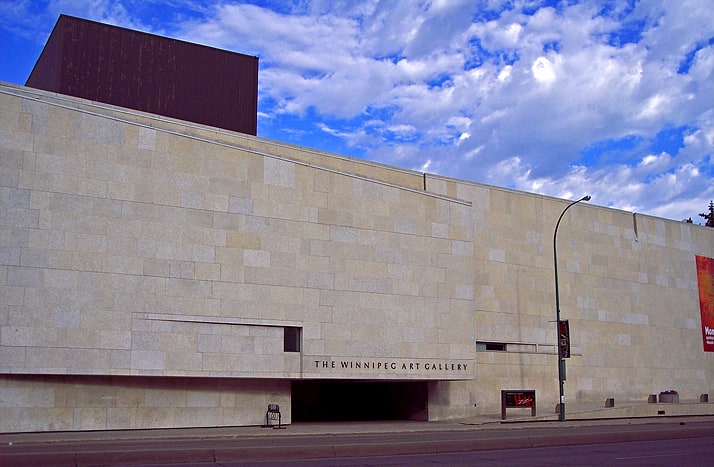
Art museum in Winnipeg, Manitoba. The Winnipeg Art Gallery is an art museum in Winnipeg, Manitoba, Canada. Its permanent collection includes over 24,000 works from Canadian, indigenous Canadians, and international artists. The museum also holds the world's largest collection of Inuit art. In addition to exhibits for its collection, the museum has organized and hosted a number of travelling arts exhibitions. Its building complex consists of a main building that includes 11,000 square metres of indoor space and the adjacent 3,700-square-metre Qaumajuk building.
The present institution was formally incorporated in 1963, although it traces its origins to the Winnipeg Museum of Fine Arts, an art museum opened to the public in 1912 by the Winnipeg Development and Industrial Bureau. The bureau opened the Winnipeg School of Arts in the following year, and operated the art museum and art school until 1923, when the two entities were incorporated as the Winnipeg Gallery and School of Arts. In 1926, the Winnipeg Art Gallery Association was formed to assist the institution in operating its museum component. The Winnipeg Gallery and School of Art was dissolved in 1950, although its collection was loaned indefinitely to the Winnipeg Art Gallery Association, who continued to exhibit it.
In 1963, the Winnipeg Art Gallery Association was formally incorporated as the Winnipeg Art Gallery by the Legislative Assembly of Manitoba. The museum moved to its present location in September 1971, with the opening of a purpose-built building designed by Gustavo da Roza. In 2021, the museum opened a Michael Maltzan-designed Qaumajuk building in order to house the museum's Inuit art collection.[12]
Address: 300 Memorial Blvd, R3C 1V1 Winnipeg (Central Winnipeg)
Maison Gabrielle-Roy
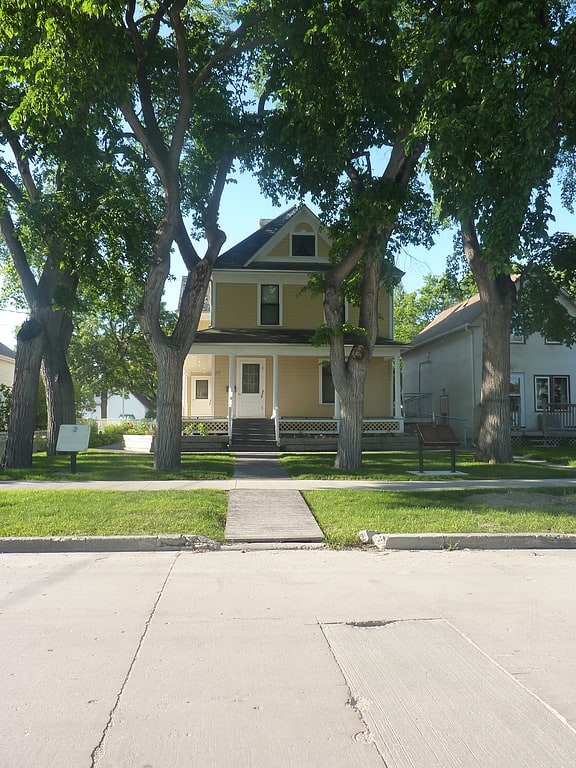
Museum in Winnipeg, Manitoba. The Maison Gabrielle Roy —translated in English as the House of Gabrielle Roy —is a museum in the former home of writer Gabrielle Roy. The house is located in the Saint Boniface area of Winnipeg, Manitoba, Canada. The objective of the museum is to disseminate the works of Roy and to preserve a piece of heritage for Canadian history.
From 1909 to 1937, Roy lived in the heart of Saint Boniface. The house was restored and opened to the public in 2003. The site was designated a National Historic Site of Canada in 2008.
The Museum is open year round and offers services in English or French. It is affiliated with: CMA, CHIN, and Virtual Museum of Canada.[13]
Address: 375 Deschambault St, R2H 0J9 Winnipeg (Saint Boniface)
Manitoba Museum

Big museum with natural history exhibits. The Manitoba Museum, previously the Manitoba Museum of Man and Nature, is a historical museum in Winnipeg, Manitoba, as well as the province's largest, not-for-profit centre for heritage and science education.
Located close to City Hall, the museum was designed in 1965 by Herbert Henry Gatenby Moody of Moody and Moore. Including its planetarium and Science Gallery exhibit, the museum focuses on collecting, researching, and sharing Manitoba's human and natural heritage, culture, and environment.
The Hudson's Bay Company donated its historic 3-centuries-old collection (and supporting funds) to the Museum in 1994, becoming the largest corporate donation ever received by the Museum. The Institute for Stained Glass in Canada has documented the stained glass at the museum.[14]
Address: 190 Rupert Ave, R3B 0N2 Winnipeg (Central Winnipeg)
Burton Cummings Theatre
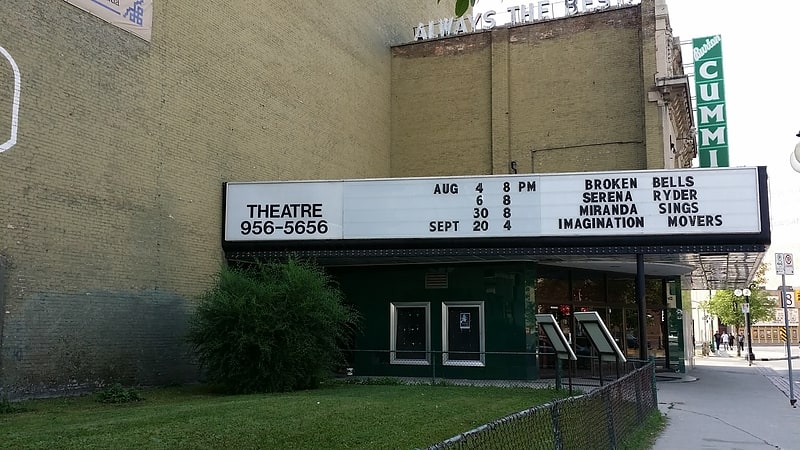
Theatre in Winnipeg, Manitoba. The Burton Cummings Theatre is a theatre located in Winnipeg, Manitoba, Canada. Built by local impresario Corliss Powers Walker, it was originally known as the Walker Theatre. The building was renamed after singer-songwriter and Winnipeg native Burton Cummings in 2002.[15]
Address: Winnipeg, 364 Smith St, Winnipeg, MB R3B 2H2
Louis Riel Sculpture
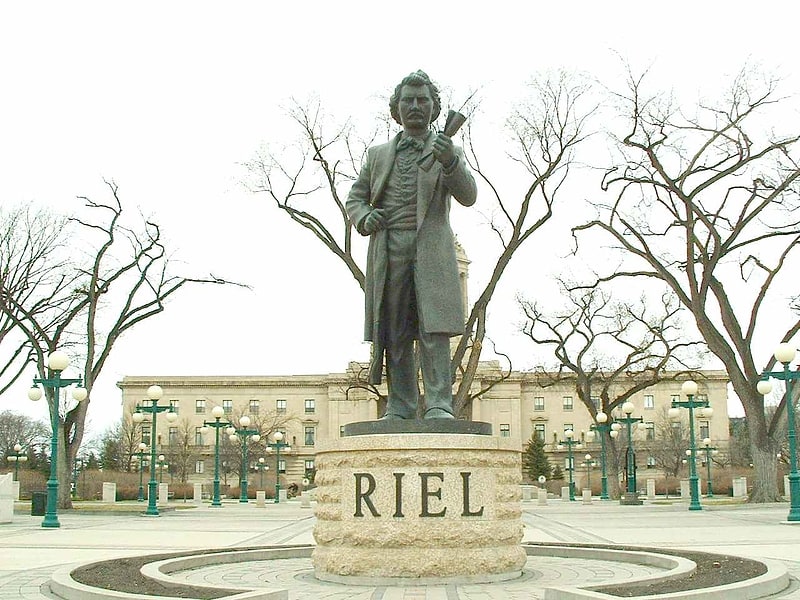
Sculpture by Miguel Joyal. The Louis Riel sculpture is a monument to Louis Riel located on the grounds of the Manitoba Legislative Building in Winnipeg. Commissioned by the Manitoba Metis Federation and sculpted by Miguel Joyal, the statue is located on the building's south grounds and faces the Assiniboine River.
Standing at 3.5 metres (11 ft) tall, the statue depicts Riel dressed in a 19th-century shirt, overcoat, trousers, and moccasins. Riel is shown standing with clenched fists, with his left hand holding a parchment to represent the Manitoba Act.
The cost for the statue was estimated to be $200,000, and was to be shared equally between the MMF and the Province of Manitoba. In 1994, the MMF failed to raise the necessary amount, and the federal government contributed $15,000.[16]
Norwood Bridge

Bridge in Winnipeg, Manitoba. The Norwood Bridge is a five-span, 167-metre vehicular bridge over the Red River in Winnipeg, Manitoba. The bridge links downtown Winnipeg with the Norwood neighbourhood of St. Boniface, Winnipeg, and serves Route 52.
The bridge bears a sculpture, called River Arch, between the east and west spans at the southern landing.[17]
Fort Garry
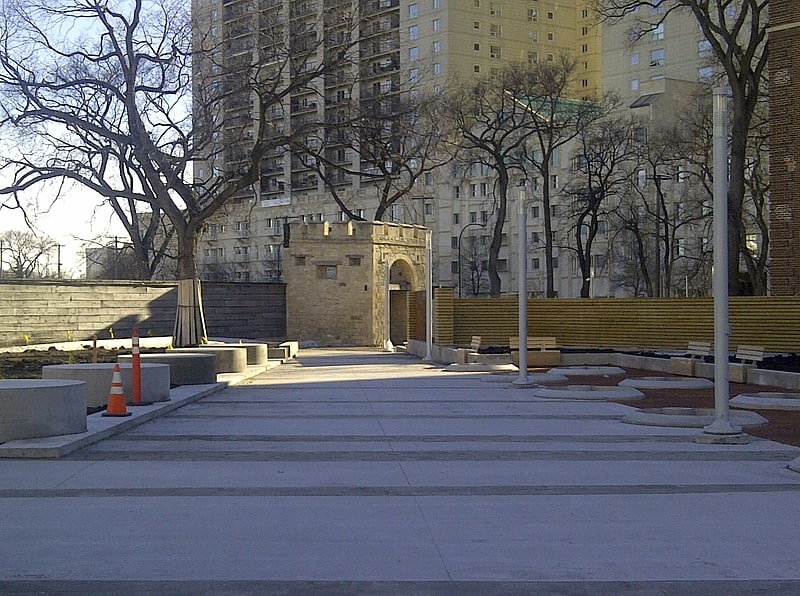
Landmark park with regular light shows. Fort Garry, also known as Upper Fort Garry, was a Hudson's Bay Company trading post at the confluence of the Red and Assiniboine rivers in what is now downtown Winnipeg. It was established in 1822 on or near the site of the North West Company's Fort Gibraltar established by John Wills in 1810 and destroyed by Governor Semple's men in 1816 during the Pemmican War. Fort Garry was named after Nicholas Garry, deputy governor of the Hudson's Bay Company. It served as the centre of fur trade within the Red River Colony. In 1826, a severe flood destroyed the fort. It was rebuilt in 1835 by the HBC and named Upper Fort Garry to differentiate it from "the Lower Fort," or Lower Fort Garry, 32 km downriver, which was established in 1831. Throughout the mid-to-late 19th century, Upper Fort Garry played a minor role in the actual trading of furs, but was central to the administration of the HBC and the surrounding settlement. The Council of Assiniboia, the administrative and judicial body of the Red River Colony mainly run by Hudson's Bay Company officials, met at Upper Fort Garry.
In 1869, the Hudson's Bay Company agreed to surrender its monopoly in the North-West, including Upper Fort Garry. In late 1869 and early 1870, the fort was seized by Louis Riel and his Métis followers during the Red River Rebellion. After the Rebellion, the area around the fort continued to grow. In 1873, the city of Winnipeg was established and the name Fort Garry was no longer used. In 1881-1884 the majority of the fort was demolished to straighten Main Street (it was at Main Street and Assiniboine Avenue).
Although only the main gate of the fort remains today, the name "Fort Garry" lives on through various institutions and businesses. An area or division of Winnipeg running along the Red River south of the original fort is called Fort Garry. The hotel beside the fort is called the Fort Garry Hotel, which was originally constructed for the Grand Trunk Pacific Railway company. Fort Street and Garry Street are on either side of the hotel. Many companies have adopted the name, such as Fort Garry Industries and the Fort Garry Brewing Company. The Fort Garry Horse has been a component of the Winnipeg military garrison throughout the 20th and into the 21st centuries.[18]
Address: 130 Main Street, R3C 1A4 Winnipeg (Central Winnipeg)
Shaw Park
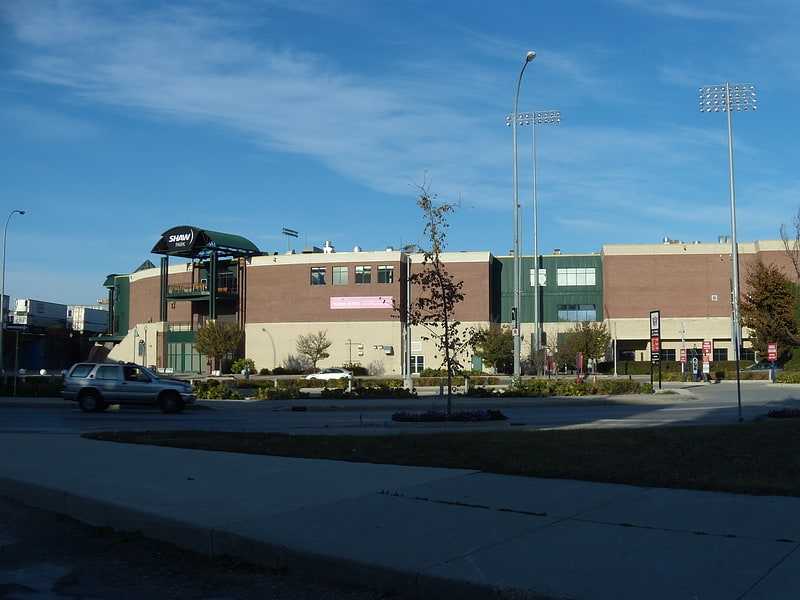
Stadium in Winnipeg, Manitoba. Shaw Park is a baseball stadium in Winnipeg, Manitoba, Canada. It is located adjacent to The Forks, near the city's downtown, and is home to the Winnipeg Goldeyes of the American Association.[19]
Address: 1 Portage Ave E, R3B 3N3 Winnipeg (Central Winnipeg)
Esplanade Riel
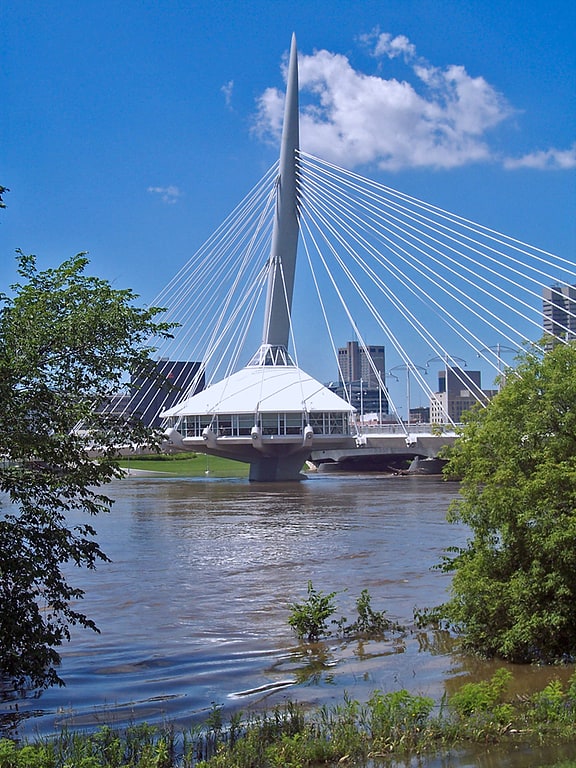
Pedestrian bridge in Winnipeg, Manitoba. Esplanade Riel is a pedestrian bridge located in Winnipeg, Manitoba. It was named in honour of Louis Riel.
It is a side-spar cable-stayed bridge which spans the Red River connecting downtown Winnipeg with St. Boniface; it is paired with a vehicular bridge, the Provencher Bridge. The bridge includes an architectural composite tower that is prestressed with a cantilevered and stayed semi-circular plaza area at the base of the tower. The plaza provides space for commercial activities and as well as a restaurant.
The Esplanade Riel is the only bridge with a restaurant in North America. Its first restaurant was a Salisbury House. Salisbury House is a chain restaurant local to Winnipeg. The next tenant was Chez Sophie sur le pont (on the bridge), which opened in the summer of 2013 and closed in February 2015. The Esplanade Riel has become a landmark and is used in many promotional materials.
Opened to foot traffic in 2003 and having a grand opening in the summer of 2004, the Esplanade Riel was co-designed by architects Guy Préfontaine and Étienne Gaboury of Gaboury Préfontaine Perry Architects Inc. The original drawing rests in the Engineering building of the University of Manitoba in Winnipeg.
The Esplanade Riel was built as part of the Provencher Twin Bridges project, a $72 million project which included a new four-lane divided vehicular bridge as well as new roadways and sidewalks linking the bridges to Downtown Winnipeg and Waterfront Drive.
In January 2013 the City of Winnipeg terminated the lease with Salisbury House and in March the city approved a five-year lease agreement with the French restaurant Chez Sophie sur le pont. The original Chez Sophie, founded in 2005, is located on Avenue de la Cathedrale. The restaurants are operated by Stephane and Sophie Wild, who are from the Alsace region of France. Chez Sophie closed on February 2, 2015.
Mon Ami Louis opened as the new tenant in July 2015, serving more "approachable" fare, as opposed to haute cuisine. It closed in 2020.[20]
Address: The Forks, Winnipeg (Saint Boniface)
Bruce Park
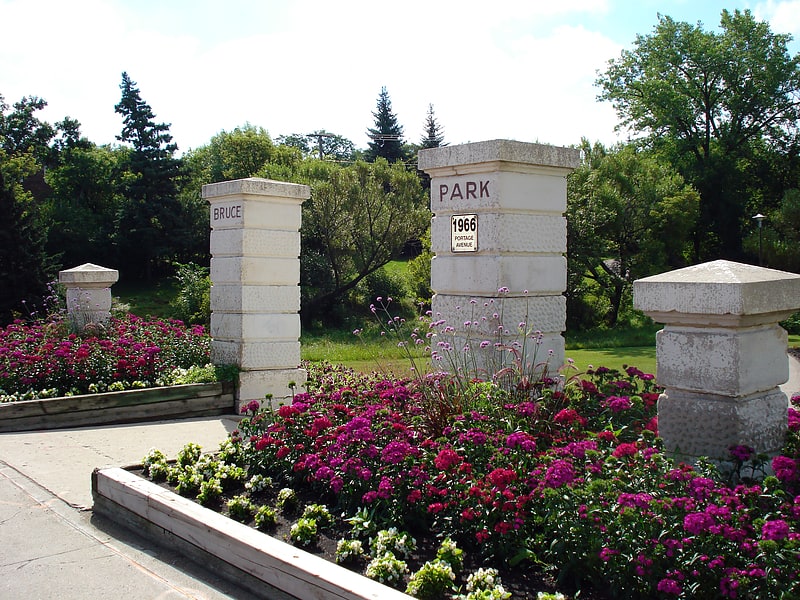
Park in Winnipeg, Manitoba. Bruce Park is a 13-acre urban park located at 1966 Portage Avenue, in Winnipeg, Manitoba, Canada. The park is bordered to the south by the Assiniboine River, to the east by Douglas Park Road, to the west by Deer Lodge Place, and to the north by Portage Avenue.
The park has three footbridges that cross the Truro Creek, which runs through the park. Features of the park include formal flower gardens, grassland and forest naturalization areas, the A.W. Hanks Walkway, the Bruce Park Cenotaph war memorial, a playground, and a wading pool. The park is open year-round.[21]
Portage and Main
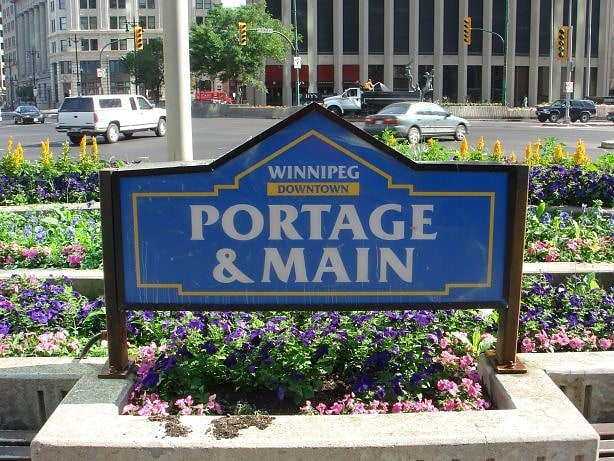
Historical landmark in Winnipeg, Manitoba. Portage and Main is an intersection in downtown Winnipeg, Manitoba, Canada, located where Portage Avenue and Main Street intersect. The corner is known as the "crossroads of Canada", due to its relative proximity to the longitudinal centre of Canada.
Formally, Portage & Main is a designated neighbourhood including the blocks immediately surrounding the intersection, within larger Fort Rouge–East Fort Garry city ward.[22]
Kildonan Park

Park in Winnipeg, Manitoba. Kildonan Park is a park in the West Kildonan area of northern Winnipeg, Manitoba, Canada.
Established in 1909 as a 73-acre (30 ha) park, it features the Peguis Pavilion, Rainbow Stage, the Witch's Hut, an Olympic-sized outdoor swimming pool, duck pond, and soccer field as well as picnic tables and barbecue pits. The Park was originally designed by George Champion who was the park's Superintendent. There are picnic sites and shelters available for rent. In winter the park features a skating pond and two tobogganing slides.
Kildonan Park features 39 hectares (390,000 m2) of park area, 25 hectares (250,000 m2) of mowable turf and 27,000 square metres (2.7 ha) of pathways, including a perimeter path measuring 1.9 kilometres (1.2 mi).[23]
Address: 2015 Main Street, R2V 2B9 Winnipeg (Seven Oaks)
Assiniboine Park Zoo
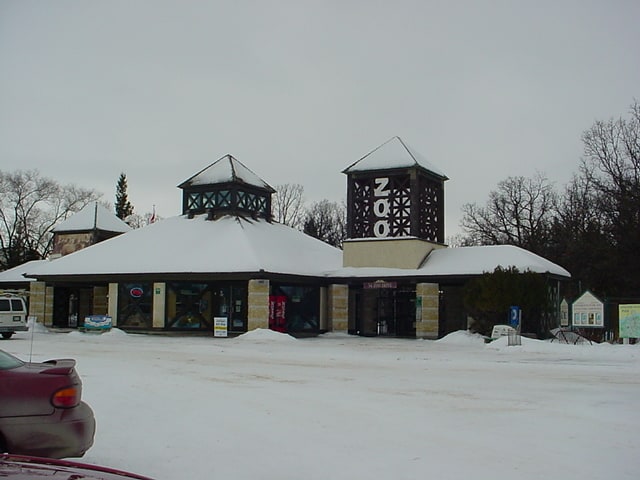
Zoo in Winnipeg, Manitoba. Assiniboine Park Zoo is an 80-acre zoo at the west end of Assiniboine Park in Winnipeg, Manitoba, Canada. It has been best known for decades for its polar bear exhibit, of which the old enclosure was replaced in 2013 with Journey to Churchill.
Established in 1904, it is managed by the Assiniboine Park Conservancy, and accredited by the Canadian Association of Zoos and Aquariums (CAZA) and the Association of Zoos and Aquariums (AZA).[24]
Address: 460 Assiniboine Park Dr., Winnipeg (Assiniboine South)
Pavilion Gallery Museum
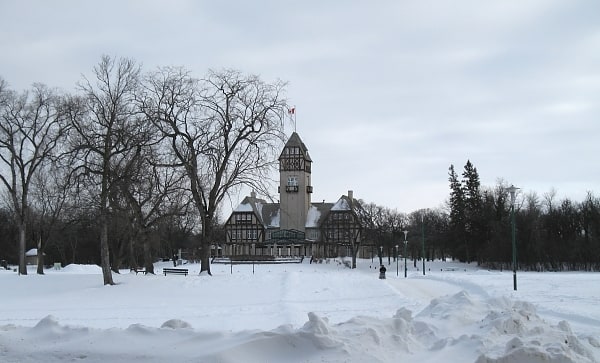
Museum in Winnipeg, Manitoba. The Assiniboine Park Pavilion is a landmark building at Assiniboine Park in Winnipeg, Manitoba, Canada. It is today one of Winnipeg's most familiar landmarks.
Among other things, the building houses the Pavilion Gallery Museum, a museum and art gallery that opened in 1998.[25]
Address: 55 Pavilion Cres, R3P 2N6 Winnipeg (Assiniboine South)
Le Musée de Saint-Boniface Museum
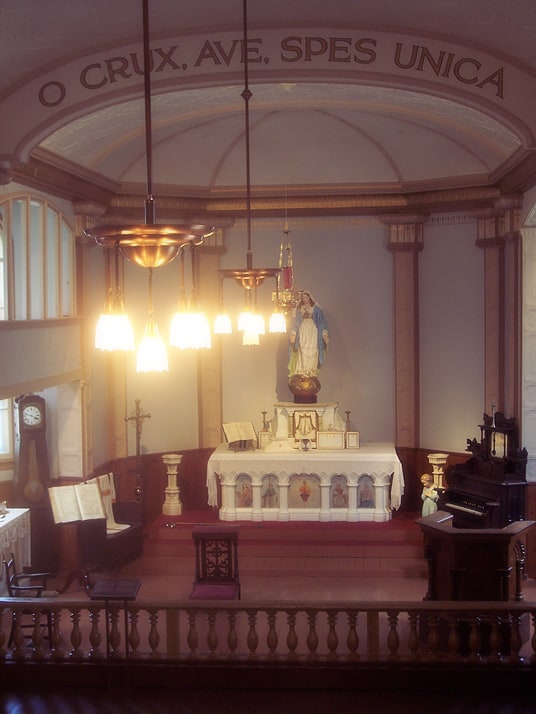
Museum in Winnipeg, Manitoba. Le Musée de Saint-Boniface Museum is a museum in Winnipeg, Manitoba, Canada, that is dedicated to Franco-Manitoban and Métis culture and history.
It is located in the oldest building in Winnipeg, a former convent run by the Grey Sisters. Begun in 1846 and finished in 1851, the former nunnery has been an orphanage, a school, a seniors' home, and was the first incarnation of the St. Boniface Hospital.
The Museum is affiliated with CMA, CHIN, and Virtual Museum of Canada.[26]
Address: 494 Tache Ave, R2H 2B2 Winnipeg (Saint Boniface)
Pantages Playhouse Theatre
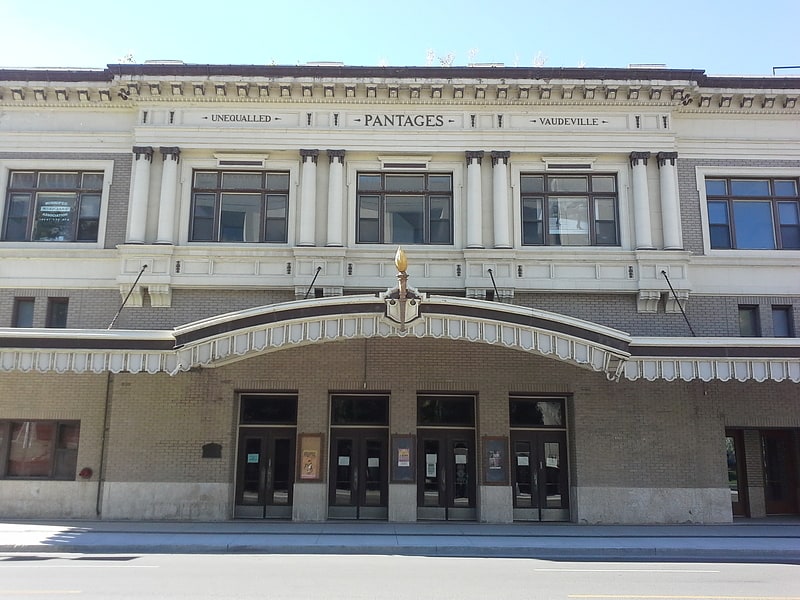
Theatre in Winnipeg, Manitoba. The Pantages Playhouse Theatre is a former vaudeville theatre in downtown Winnipeg, Manitoba, Canada.
The two-storey building features a decorative façade with a lit marquee across the front, as well as classical decorative elements such as columns, brackets, frieze and cornice. The building continues to feature original interior layout and original lobby decor such as marble sheathing and decorative plaster ceiling.
Of the 75 theatres once found in Pantages' chain, the theatre in Winnipeg is one of the few that have survived.[27]
Address: 180 Market Ave, R3B 0P7 Winnipeg (Central Winnipeg)
Statue of Queen Victoria
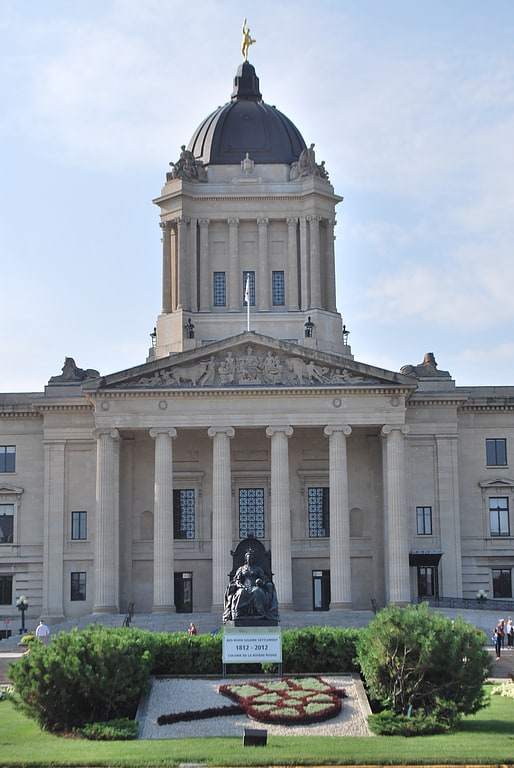
The Queen Victoria Statue was a sculpture of Queen Victoria that stood on the grounds of the Manitoba Legislative Building in Winnipeg, Manitoba, Canada.
It was designed by the British sculptor George Frampton, it cost $15,000, and was paid for by a mixture of public funds and private donations. Frampton used the same model of the seated queen in two other statues, the Statue of Queen Victoria, in St Helens, Merseyside, and the Memorial to Queen Victoria, in Leeds, West Yorkshire, both in England. The statue was unveiled on 1 October 1904 by Sir Rodmond Roblin. The statue depicts the queen seated on a throne with the sceptre in her right hand, and an orb in her left hand.
During the night of 23 June 2020, the statue was vandalized with red and white paint amid a wave of anti-racist protests. On 1 July 2021, on Canada Day, the statue was toppled and covered in paint during a protest denouncing the deaths of Indigenous children in Canadian residential schools. The head, crown, and the orb of the statue were removed by force by protesters overnight, though the head was later recovered from the Assiniboine River without its crown. The statue is currently being assessed for restoration.[28]
Provencher Bridge
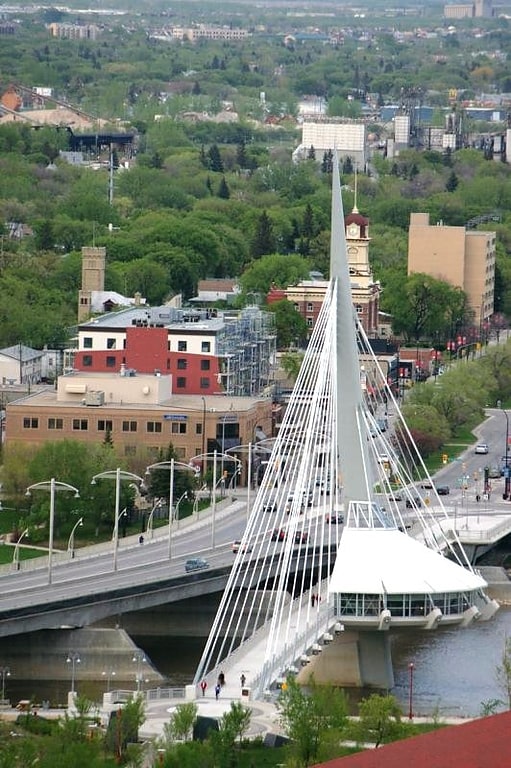
Bridge in Winnipeg, Manitoba. The Provencher Bridge is a bridge across the Red River in Winnipeg, Manitoba. The bridge links downtown Winnipeg with St. Boniface, a Winnipeg community across the Red River. The Provencher Bridge derived its name from the connecting Boulevard Provencher.
The bridge serves Route 57 and is a main connector from downtown Winnipeg to most of the eastern communities in Winnipeg. The speed limit on the bridge is 50 km/h (31 mph).[29]
Riel House

Museum in Winnipeg, Manitoba. Riel House is a National Historic Site commemorating the life of the Métis politician and activist Louis Riel, and also the daily life of Métis families in the Red River Settlement. The house is situated in the historic St. Vital parish, Winnipeg in Manitoba Canada. From 1865, the residence belonged to Riel's mother, Julie Riel, and housed his brothers and their families. Louis Riel lived along with them from his return to Red River in 1868, through the Red River Resistance, until his exile in 1870. It is also where his body lay in state for two days in December 1885 after his sentencing and execution for murder and treason, before being buried in St. Boniface. The house remained within the possession of Riel descendants until 1968, when it was acquired by the Winnipeg Historical Society.
The house was restored to its 1886 condition, and converted into a museum. It was designated a National Historic Site in 1976 and a Federal Heritage Building in 2000. It is owned and administered by Parks Canada, but since 2013 the Louis Riel Institute (an associate of the Manitoba Métis Federation) has provided interpretation and programming.[30]
Address: 330 River Rd, R2M 3Z8 Winnipeg (Saint Vital)
Richardson Building
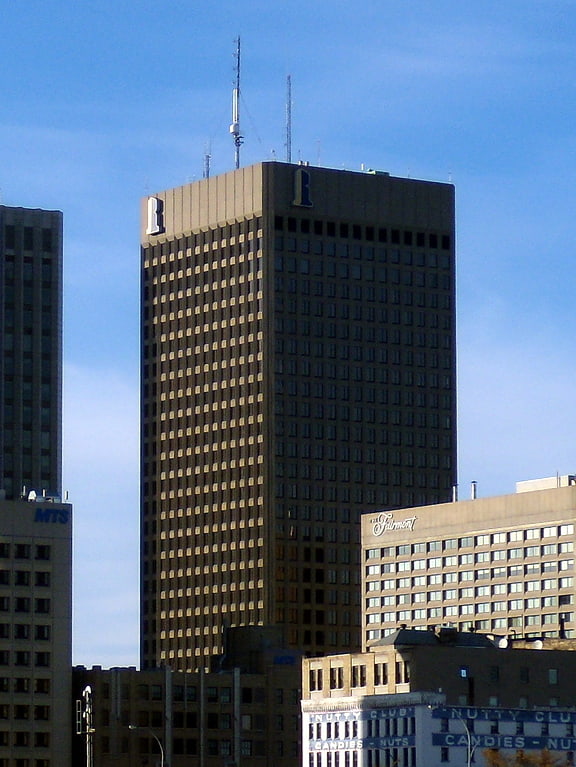
Building in Winnipeg, Manitoba. The Richardson Building is a 34-storey office tower at the intersection of Portage and Main in Winnipeg, Manitoba, Canada. The building forms the anchor of the Lombard Place development, and is connected to Winnipeg Square shopping mall via the Portage and Main Concourse. The thirty-four storey building stands 124 metres tall, making it the third tallest building in Winnipeg. It is dressed in granite chip pre-cast concrete and solar bronze double-glazed glass.
In 2011, the CBC moved its digital television transmitters for CBWT-DT and CBWFT-DT to the Richardson Building, on a new antenna that raised the pinnacle of the building to 151.8 metres (498 ft), once again making it the tallest structure in Winnipeg.[31]
Golden Boy
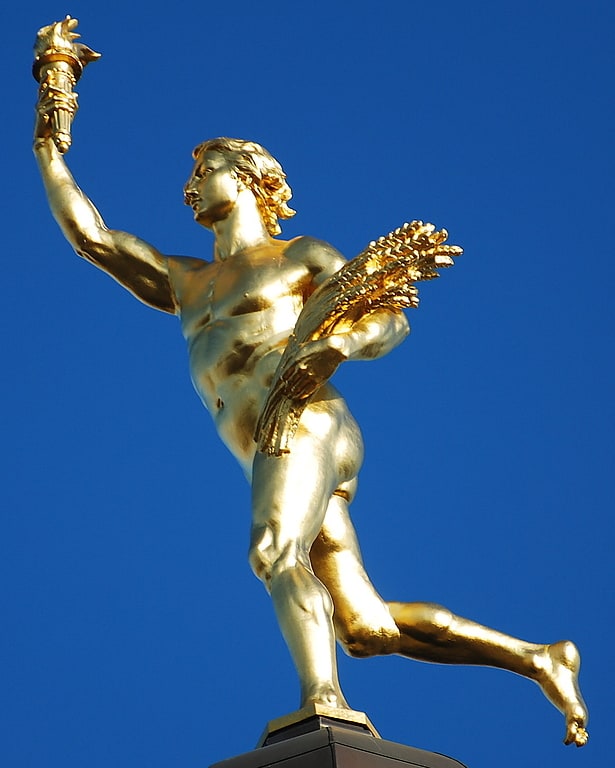
Statue by Georges Gardet. The Golden Boy is a northward-facing statue perched on the dome of the Manitoba Legislative Building in Winnipeg, Manitoba, Canada. Arguably the province's best-known symbol, the statue was modeled after the Roman god Mercury and is meant to represent the prosperity and entrepreneurial spirit of Manitoba.
Weighing 1,650 kilograms (3,640 lb), it stands 5.25 metres (17.2 ft) tall from the toe to the top of the torch, and 4.27 metres (14.0 ft) from head to toe. When first installed, the tip of his torch—at 77 metres (253 ft) above ground—was the tallest point in all of Winnipeg.
With the exception of several months in 2002 when the statue was lowered for restoration (including regilding), the Golden Boy has stood atop the Legislative Building since its opening.[32]
Cathedral of St. John

Cathedral in Winnipeg, Manitoba. St. John's Cathedral is an Anglican cathedral in Winnipeg, Manitoba, Canada, which is the cathedral church of the Diocese of Rupert's Land. It is located in the Luxton neighbourhood of north-end Winnipeg on Anderson Avenue near Main Street and the Red River. St. John's Cathedral marks the birthplace of the Anglican Church in western Canada.[33]
Address: 135 Anderson Avenue, Winnipeg (Point Douglas)
The Meeting Place
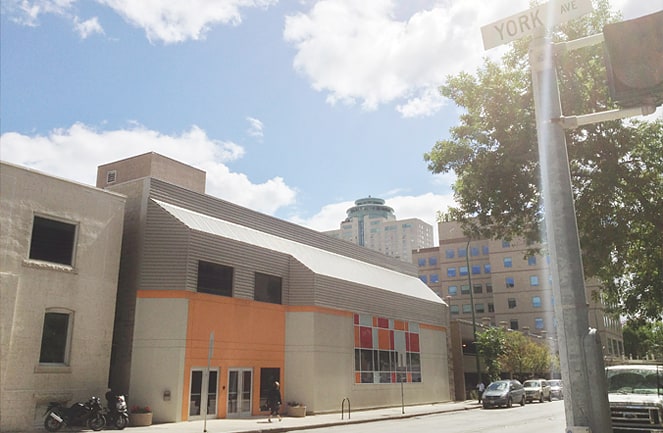
Church in Winnipeg, Manitoba. The Meeting Place is an evangelical Mennonite church located in downtown Winnipeg, Manitoba. It is a member of the Canadian Conference of Mennonite Brethren Churches and the Mennonite Brethren Church of Manitoba.
The Meeting Place's mission statement is "to be a biblically-functioning community leading people to become fully devoted followers of Jesus Christ." In June 2013 the membership established a vision statement to encourage and challenge the church to be about both experiencing and expressing compassion: "Reordering our lives for the compassionate cause of Jesus in our friendships, our city, and our world."
The Meeting Place is about a casual and inclusive Sunday morning experience. There is no dress code, and all are welcome to attend. The services sometimes include drama, dance, and visual art as ways of allowing people to connect with God, and feature relevant and understandable messages of about 25 minutes that are most often part of a teaching series. The worship band occasionally plays songs from popular music. There is a cafe at the back of the meeting space and attendees are permitted to enjoy food and drink during the service. All of this is done in order to create an atmosphere in which both people who have attended church much of their lives, as well as those who have maybe never attended church, can feel comfortable, but also be challenged to believe the Bible and live according to what it teaches. Most weeks from September through June there are two services of just over an hour each Sunday morning at 9 and 11 a.m. During the summer, TMP offers one service at 10 a.m.[34]
Address: 139 Smith Street, Winnipeg (Central Winnipeg)
Ukrainian Cultural and Educational Centre
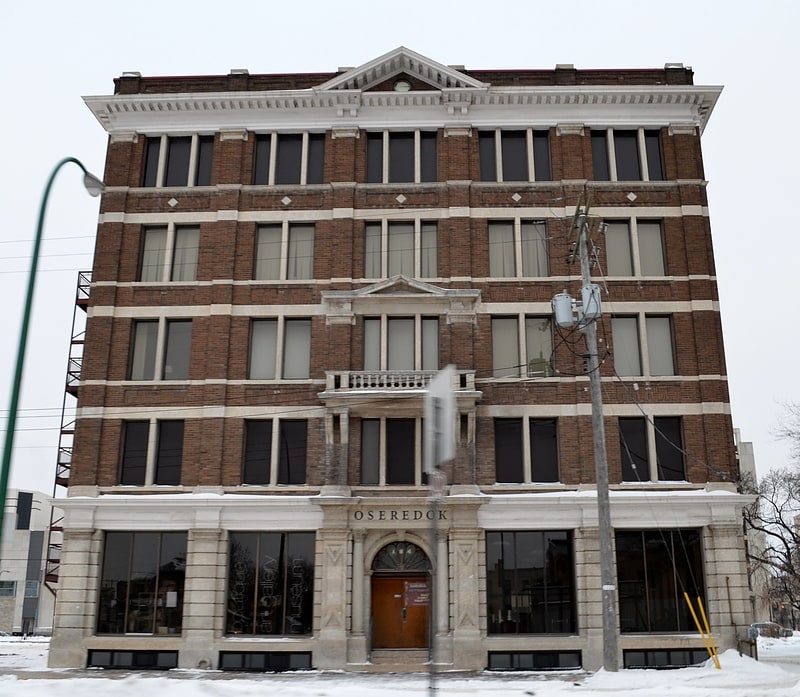
Museum in Winnipeg, Manitoba. The Ukrainian Cultural and Educational Centre —also known as Oseredok —is a museum, gallery, and library in Winnipeg, Manitoba, celebrating the Ukrainian Canadian community. It is the largest Ukrainian cultural institution of its kind in Canada.
Founded in 1944 by the Ukrainian National Federation of Canada, the museum collects and preserves materials and artifacts including documents, ancient maps, rare books, film, photographs, items of folk art, pioneers' tools, musical instruments, and regional folk costumes. The gallery exhibits work of Canadian and international Ukrainian artists.
The library holds over 40,000 books and periodicals in Ukrainian and English including collections of children's books, folklore, music, humanities and sciences, a rare book collection and reference materials.
The museum is affiliated with the CMA, CHIN, and Virtual Museum of Canada.[35]
Address: 184 Alexander Ave, R3B 0L6 Winnipeg (Central Winnipeg)